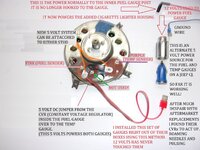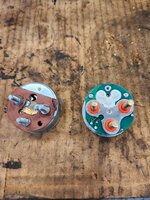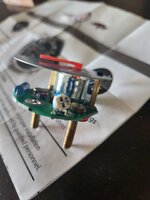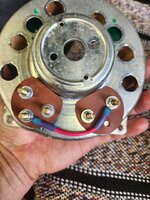Some simple checks you can do:
1. Pull gauge fuse before doing resistance checks (ohms or continuity) on gauge cluster to ensure no voltage is present.
2. To eliminate reading through other components besides the gauges, disconnect the purple wire on the temp sending unit on the engine and disconnect the ground on the fuel level sending unit at the rear of the vehicle. Both of these sending units connect to ground normally and will cause your resistance measurements on the various terminals on the back of the gauges to give readings that are not through the gauges themselves. Or just pull the cluster and have it on the work bench.
3. Use VOM to check resistance between "I" terminal on back of fuel gauge (red wire where +12V comes in from the fuse) to ground. Should be approximately 50 ohms. Less indicates a short. Higher indicates a defective gauge.
4. Use VOM to check resistance between "S" terminal on back of fuel gauge (pink wire from the sender unit in the gas tank) to ground. This reading will vary based on the amount of fuel in the tank if you didn't disconnect the ground. To eliminate that variance, disconnect the ground wire from the sending unit itself at the rear of the vehicle. Now your measurement will not measure the resistance of the sending unit, but any possible short in the wiring going from the gauge cluster to the sending unit (running from front to rear of the vehicle). Should read around 70 ohms as you are now reading the same original 50 from the prior step, plus an extra 20 or so through the gauge mechanism itself. Higher? Gauge is bad. Lower means a short somewhere.
5. Use VOM to read terminal "A" on the fuel gauge to ground. This is the insulated "strap" that goes between the fuel gauge and the temp gauge. Inside the fuel gauge, the +12V is dropped to about +5V to supply the temp gauge. Should be about 50 ohms.
6. Now use VOM to measure between the "A" terminal on the fuel gauge to the terminal on the temp gauge where the purple wire connects (coming from the temp sending unit). This is reading through the temp gauge mechanism and should about 20 ohms.
7. Now with the purple wire disconnected from the gauge, measure from that purple wire to ground. This should read nothing, or infinity, since the temp sending unit is disconnected. If you get a reading, that wire is shorted somewhere.
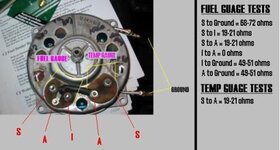 Most common areas for shorts are as follows:
Most common areas for shorts are as follows:
1. Purple wire from back of temp gauge going through the bulkhead connector on the firewall out to the temp sending unit on the engine. This wire can get pinched or has been damaged under the dash or in the engine bay; most common in the engine bay where insulation can be burned/cracked and it's touching a ground contact somewhere.
2. Insulated "strap" between fuel gauge and temp gauge when the internal voltage regulator (inside the fuel gauge) shorts/fails and a higher voltage (full +12 instead of lower +5) is present. This is common even in new aftermarket gauges with poor voltage regulators. See below for an option to mod this.
3. Gauge mounting screws. The mounting screws for the fuel and temp gauges rely on small insulators around the mounting screws to keep the terminals insulated from ground. If these are damaged, missing, or tightened too much when installing, these terminals can get grounded where they're not supposed to be. The resistance checks above should identify if this has happened.
Mod for +5V regulator:
1. Use a standard USB charger adaptor that plugs into a +12V cigarette lighter socket.
2. Disconnect the +12V red wire from the "I" terminal on the back of the fuel gauge. This is the power feed that comes from the fuse that is blowing.
3. Connect that red wire instead to a cigarette lighter socket. Also connect a ground wire to the socket so it now has both +12V and ground to be powered up.
4. Plug the USB power adaptor into this socket.
5. Use a USB cable with the "A" plug (standard USB plug) still in place, but cut off the other end (whatever it had; mini-USB or micro-USB or USB-C, whatever).
6. Use the VOM to determine which of the 2 or 4 wires in the USB cable has the +5V on it. Some USB cables have 4 wires if the supply both voltage and data. Others that are charger cables only just have 2 wires (+5V and ground).
7. Solder a ring lug on the wire with the +5V on it. Eliminate/insulate the other wire(s) in the USB cable.
8. Connect the ring lug to either end of the "strap" connector on the back of the gauges. This will supply the needed +5V for the gauges to work. The original +12V red wire from the fuse is no longer connected to the rear of the gauges. It is only connected to the power socket your USB charge adaptor is plugged into. Both the fuel and the temp gauges will run fine with this +5V supply attached to the "strap".
